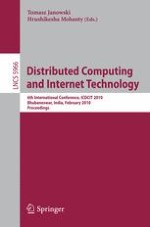2010 | Buch
Distributed Computing and Internet Technology
6th International Conference, ICDCIT 2010, Bhubaneswar, India, February 15-17, 2010. Proceedings
herausgegeben von: Tomasz Janowski, Hrushikesha Mohanty
Verlag: Springer Berlin Heidelberg
Buchreihe : Lecture Notes in Computer Science
